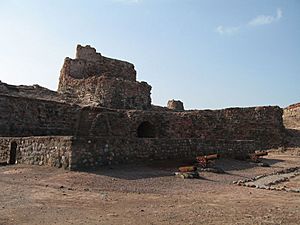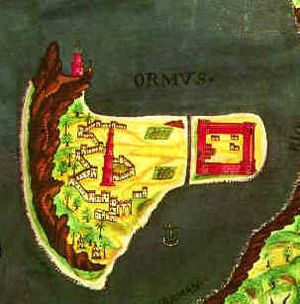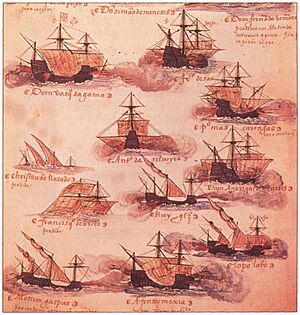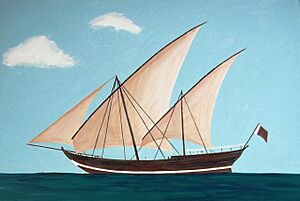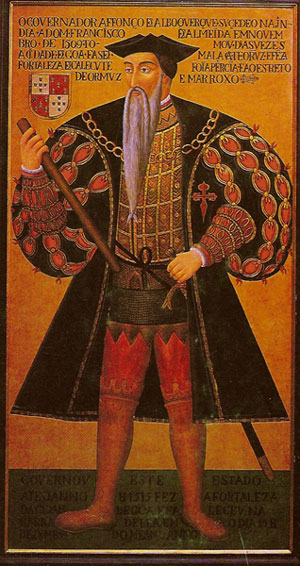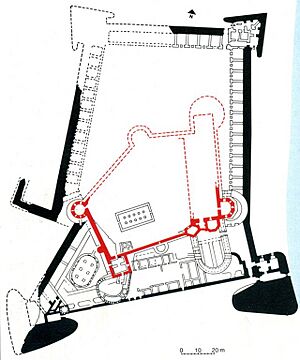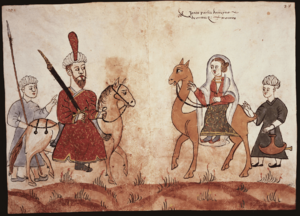Portuguese conquest of Hormuz facts for kids
Quick facts for kids Capture of Hormuz |
|||||||||
|---|---|---|---|---|---|---|---|---|---|
| Part of the Portuguese–Safavid wars | |||||||||
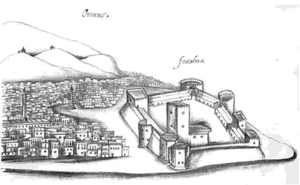 The city and fortress of Hormuz in the 16th century, depicted by Gaspar Correia in Lendas da Índia. |
|||||||||
|
|||||||||
| Belligerents | |||||||||
| Kingdom of Hormuz | |||||||||
| Commanders and leaders | |||||||||
| Hwaga Ata Bahrudin Shirazi |
|||||||||
| Strength | |||||||||
| 460 men 6 naus |
4,000 men | ||||||||
| Casualties and losses | |||||||||
| 11 wounded | 900 dead | ||||||||
The Portuguese capture of Hormuz happened in 1507. A Portuguese leader named Afonso de Albuquerque attacked Hormuz Island. His goal was to build a strong fort there. This victory gave Portugal control over important trade routes. These routes connected India and Europe through the Persian Gulf.
Contents
Why Hormuz Was Important
King Manuel I of Portugal had a big plan in 1505. He wanted to control trade in the Indian Ocean. He aimed to stop Muslim traders from using certain routes. To do this, he planned to capture three key places:
- Aden, to block trade through the Red Sea.
- Hormuz, to block trade through Beirut.
- Malacca, to control trade with China.
In April 1506, two Portuguese fleets sailed from Lisbon. Their first mission was to capture Socotra island. They wanted to build a fort there. Afonso de Albuquerque was in charge of blocking Muslim ships in the Red Sea.
After a very long journey, the fleet reached Socotra in April 1507. The Portuguese took over a local fort. But Socotra was not as rich as they thought. Food supplies became very low. So, on August 10, Albuquerque sailed towards the Strait of Hormuz. He hoped to find supplies there. He also had secret orders to take over Hormuz.
Portugal Takes Over Oman
In the early 1500s, the coastal cities of Oman were part of the Kingdom of Hormuz. They were ruled by governors.
On August 22, 1507, Albuquerque's ships reached Qalhat. The governor there chose to make peace. He gave the Portuguese food and exchanged hostages. But Qurayyat tried to fight back. The Portuguese attacked and took over the town. Muscat also tried to resist, but it was also taken.
Sohar had a small fort. But it quickly gave up when the Portuguese arrived. The town was saved. Gifts were exchanged, and its governor promised to be loyal. He was given a Portuguese flag to fly.
Finally, Khor Fakkan also tried to fight. But it was taken over. The Portuguese captured an old leader there. He told Albuquerque that the Portuguese seemed as great as the army of Alexander the Great. He even gave Albuquerque a book about Alexander. This book was very special to Albuquerque. This is how the Portuguese took control of Oman.
First Capture of Hormuz in 1507
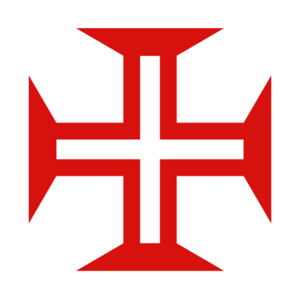
On September 26, 1507, the Portuguese ships entered Hormuz harbor. They had their flags flying and fired their cannons as a greeting.
News of the Portuguese victories in Oman had already reached Hormuz. People were very worried. Albuquerque was not met by any officials. So, he called the captain of a large trade ship to his own ship. He said he came with orders from the King of Portugal. He wanted Hormuz to become a Portuguese protectorate. He offered the city a chance to surrender without a fight.
Hormuz was ruled by a powerful minister named Cogeatar. The young king, Seyf Ad-Din, was only twelve. Cogeatar was not scared by the small Portuguese fleet. During the night, the Portuguese heard sounds of people preparing for battle. This showed that Cogeatar planned to fight.
The Battle for Hormuz
The Portuguese ships were surrounded. There were about 50 armed merchant ships on one side. On the other side, there were 120 to 200 small oar-powered boats. Albuquerque decided to use this to his advantage. He knew his cannons would be more effective against so many close targets.
The next day, around 9 a.m., the fighting began. Albuquerque's lead ship fired first. The rest of the fleet followed. Both sides fired cannons. The Portuguese had a clear advantage. Thick smoke filled the air, making it hard to see.
From the beaches, the people of Hormuz watched the battle. Even the king was there. Some people were killed by stray cannonballs.
The Hormuzi boats, filled with archers, tried to attack the Portuguese ships all at once. The Portuguese had fewer men. But the crowded enemy boats were perfect targets for their cannons. About a dozen Hormuzi boats sank. Many more were damaged. This blocked the path for other boats.
The Hormuz forces became confused. The Portuguese then went on the attack. Albuquerque's ship captured a large Gujarati trade ship. After a tough fight, it was taken over. The Portuguese then captured or burned most of the other enemy ships.
Finally, the Portuguese landed near the shipyards. They started setting fire to the edge of Hormuz. Cogeatar feared a bloody attack. He raised a white flag over the royal palace, showing surrender.
With only about 500 men and six ships, Albuquerque had defeated the strongest naval power in the Gulf.
A Difficult Time
After long talks, Albuquerque met with King Seyf Ad-Din and Cogeatar on October 10. They signed an agreement. Hormuz would pay a tribute of 15,000 ashrafi (a Persian coin). Portuguese traders would not pay customs fees. Portugal could build a fort on the island. In return, the king would keep his position under Portuguese protection.
Albuquerque ordered his soldiers to start building the fort. It was on the northern tip of the island. The Portuguese worked in shifts. They would go back to their ships at night and return in the morning. This was to hide how few Portuguese soldiers there were. The people of Hormuz were surprised to see fighting men doing manual labor.
Hormuz also paid tribute to Persia. Two Persian messengers came to Albuquerque. They demanded the tribute from him. Albuquerque gave them guns, swords, cannonballs, and arrows. He said these were the "currency" Portugal used to pay tribute.
Building the fort in the hot Hormuz climate was hard. The Portuguese captains complained. They did not want to stay in Hormuz.
In December, four Portuguese sailors ran away to Cogeatar. They told him how few Portuguese there really were. Albuquerque realized the danger. He moved all his men from the unfinished fort back to the ships. He then blocked Hormuz, hoping the lack of water would force Cogeatar to give up. But the Portuguese also had to travel far for fresh water. In January 1508, three of Albuquerque's captains left for India with their ships. Realizing his weak position, Albuquerque also left Hormuz on February 8.
Back to Socotra
Albuquerque returned to Socotra. He found the Portuguese soldiers there were starving. He sent one ship to East Africa for supplies. Albuquerque stayed in the Gulf of Aden, raiding merchant ships. In April, the supply ship returned. It brought the first news from Portugal in two years for the soldiers.
In August, Albuquerque sailed to Hormuz again to check on it. He saw that Hormuz had been well-fortified. His own ship was taking on too much water. So, he returned to India.
Albuquerque promised not to cut his beard until he had conquered Hormuz.
Portugal Takes Over Hormuz in 1515
On November 4, 1509, Albuquerque became the governor of Portuguese India.
Before returning to Hormuz, he conquered Goa in 1510. He also took Malacca in 1511. He even explored the Red Sea in 1513. Albuquerque always kept gathering information about Hormuz. He also exchanged messages with its leaders.
Important changes had happened in Hormuz between 1507 and 1515. Coge Atar had been killed. The new minister, Rais Nureddin Fali, had King Seyf Ad-Din poisoned. He put the king's 18-year-old brother, Turan Shah, on the throne. But Rais Nureddin was then removed from power by his nephew, Rais Ahmed. Rais Ahmed ruled with force. This made young Turan Shah very scared.
So, Albuquerque gathered a fleet of 27 ships and 1,500 Portuguese soldiers in Goa. In March 1515, the Portuguese ships arrived at Hormuz again. They played trumpets and fired their cannons loudly. An eyewitness said, "The ships appeared to be on fire."
Hormuz was ready for a long fight. But King Turan Shah and Rais Nureddin did not fight Albuquerque. They hoped he would help them against Rais Ahmed, who they called a "tyrant." The Portuguese had shown they were only interested in trade and tribute, not fully controlling the kingdom. So, on April 1, King Turan Shah allowed Albuquerque to land his forces. Portugal formally took control of Hormuz without a battle. The flag of Portugal was finally raised over the island.
What Happened Next
Albuquerque met with an ambassador from Shah Ismail of Persia. Shah Ismail wanted to talk with the Portuguese. Albuquerque wanted to be friends with Persia against the Ottoman Empire.
A few weeks later, Turan Shah told Albuquerque that Rais Ahmed was planning to kill him. Albuquerque asked to meet the king and his ministers. The meeting place was guarded by Portuguese soldiers. There, Albuquerque had his captains kill Rais Ahmed in front of the king. This "freed" Turan Shah from the cruel ruler. Albuquerque knighted the king. He told Turan Shah that he and his men would serve him. He said the king should not fear anyone as long as he was a friend of the King of Portugal.
Outside, a crowd had gathered. They feared the king had been killed. Turan Shah went to the palace rooftop. He spoke to the city, which now cheered for Rais Ahmed's death.
The Fortress
With Hormuz secure, Albuquerque continued building the fortress. He used his soldiers and hired local workers. He even helped with the work himself. The fort was built on the northern tip of the island. This spot was perfect for watching over the city and both harbors. It was shaped like an irregular pentagon with seven towers. It was named Fortaleza da Nossa Senhora da Conceição de Hormuz (Fortress of Our Lady of Conception of Hormuz). It had 400 Portuguese soldiers. A large pillory (a device for public punishment) was put in the marketplace. Later, a large open area was made between the fort and the city.
In 1550, the old fortress was updated and made bigger. It was designed to be better for fighting with gunpowder weapons.
Portuguese Rule
In Hormuz, Albuquerque let the local king rule. But the king was a vassal of Portugal. This meant he was under Portuguese control. The kingdom was disarmed, except for a royal guard. Portugal took control of its defense. Hormuz became a protectorate. The yearly tribute of 15,000 ashrafi was collected. Albuquerque also collected past due tribute, totaling 120,000 ashrafi. This amount would increase over the years.
Before the Portuguese arrived, there was a lot of fighting between different groups in Hormuz. This made trade decline. But the Portuguese takeover changed this. The presence of Portuguese forces also made sailing in the Gulf much safer. Kings from Basra, Bahrein, Lar, and Persian governors sent messages to Albuquerque. They wanted friendly relations. Large crowds would gather to see Albuquerque when he rode through the streets. Painters were sent to Hormuz to draw his picture.
All sea trade between India and the Middle East passed through Hormuz. Some Portuguese writers estimated Hormuz's yearly income at about 140,000 cruzados. 100,000 of that came from customs fees alone. In 1524, customs brought in 200,000 cruzados. With Hormuz secured, Albuquerque also controlled the important trade of war-horses. These horses were sent from Arabia and Persia to India through Hormuz. He directed this trade to Goa. Hormuz became a very important source of money for the Portuguese State of India.
In 1521, the king of Bahrain, who was under Hormuz, rebelled. He refused to pay tribute. Bahrain was then conquered by António Correia with help from Hormuz troops. It was added to the Kingdom of Hormuz. Later that year, the city of Hormuz itself rebelled against the Portuguese. But the rebellion was stopped. In 1523, Sohar in Oman also rebelled, but it was calmed down. Muscat and Qalhat rebelled in 1526, but they were also brought under control.
In 1552, Ottoman ships attacked Hormuz. But they failed to capture it. Hormuz and the Persian Gulf became a place of intense fighting between the Ottomans and Portuguese in the 1550s. This was part of the Ottoman–Portuguese conflicts. Portuguese and Turkish fleets fought near Hormuz in 1553 and 1554. The Turkish fleet was destroyed in the second battle. In 1559, the Ottomans tried one last time to capture Bahrain, but they failed.
The first history of Hormuz was published in Europe in 1569. A Portuguese friar named Gaspar da Cruz wrote it. He included it in his book about China.
Hormuz remained a Portuguese client-state until 1622. That year, a combined English and Persian force captured Hormuz.
See also


